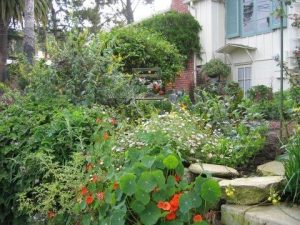A good definition of Hügelkultur, which literally translates as “mound culture,” is a type of mounded garden bed structure created by layering materials from your yard. It’s the practice of allowing items to decay for reuse. Hügelkultur is a permaculture gardening technique used in Germany and Eastern Europe for generations. It “raises” your raised bed to a new level.
There are several steps to successfully create a hügelkultur mound. Start by clearing the sod in the chosen area to a depth of about 12 inches. Set aside this material to add to the soil in the new mounded bed. Next, place decaying wood logs one or two high into this cleared space followed by branches. Fill empty spaces with wood chips and/or hay. To this structure, add leaves and top soil and compost. The structure will be triangle shaped and can be whatever length suits your yard. Once the mounded structure is shaped, top with soil 6 to 8 inches deep. This initial mound creation is the bulk of the hard manual work.
Now you are ready to plant on the sides and top of your garden bed. Keep in mind that mature plants will be much taller, depending on where they were planted on your mound, than usual. Tall plants (think of corn) may be out of reach when harvesting.
This type of gardening is similar to permaculture, regenerative gardening, and organic gardening. Utilizing natural methods of recycling decaying organic materials continues to feed nutrients back into the soil. The benefits? You are feeding your plants with nutrient rich soil built from your garden materials.
This method increases gardening space by planting up the sides and top of the garden mound and decreases the amount of water needed. You have, in essence, created a useable compost pile and garden all in one. Once started, this is a self-perpetuating garden bed with low annual input. Each original layer breaks down, creating nutrient rich soil continually, with no additional work on your part. You can plant all your favorite things—onions, greens, tomatoes, cabbage—all surrounded by perennials and annuals for color and to attract pollinators.
If critters are a problem in your area, you can line your bed with hardware cloth and/or put a chicken wire cover over the mound.
The best logs to use as a base are hard woods like oak, apple, beech and maple which have a longer breakdown time. Using slower-decaying wood allows your hügelkultur garden to last from five to ten years before the process is repeated. As the garden decays over the years, the decaying material shrinks with time.
As with all gardens, make sure the spot you select gets sufficient sun; at least six to eight hours a day is needed. Happy planting and harvesting in an earthy friendly way.
Diane Miller is a University of California Cooperative Extension Master Gardener of Tuolumne County

